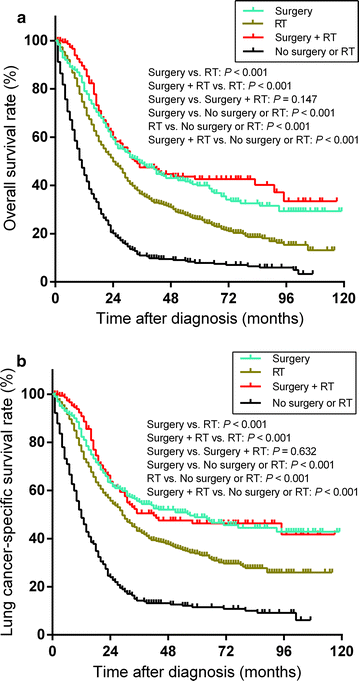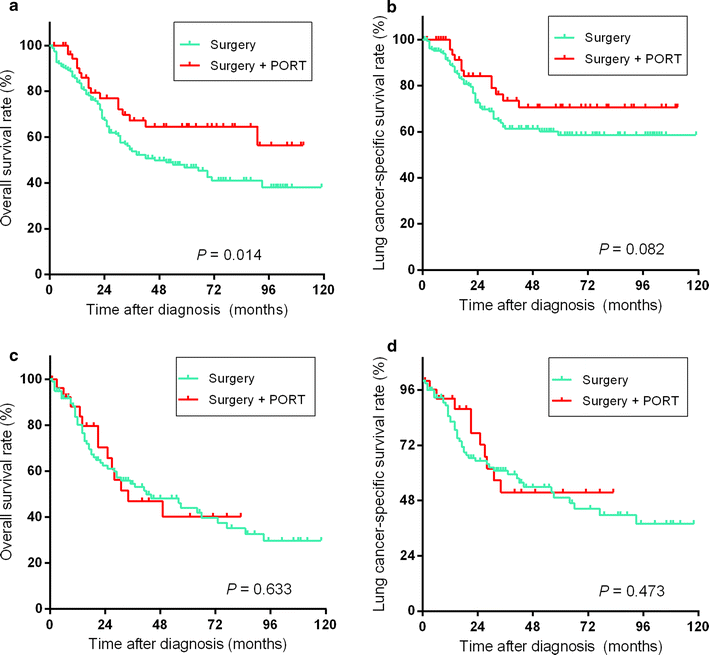Selection of candidates for surgery as local therapy among early-stage small cell lung cancer patients: a population-based analysis
- PMID: 29764484
- PMCID: PMC5993140
- DOI: 10.1186/s40880-018-0272-5
Selection of candidates for surgery as local therapy among early-stage small cell lung cancer patients: a population-based analysis
Abstract
Background: Surgery and radiotherapy are considered local therapies for small cell lung cancer (SCLC). The present study aimed to select candidates for surgery as local therapy among patients with stage I or II SCLC, based on the eighth edition of the TNM classification for lung cancer.
Methods: Patients diagnosed with SCLC between 2004 and 2013 were selected from the Surveillance, Epidemiology, And End Results database. The TNM stage of SCLC in these patients was re-classified according to the eighth edition of the TNM classification for lung cancer. Patients with stage I or II SCLC were included in the present study. Overall survival (OS) and lung cancer-specific survival (LCSS) were separately compared in the different TNM stages between patients who received surgery and radiotherapy as local therapy. Multivariate analysis was applied to evaluate multiple factors associated with survival.
Results: Among the 2129 patients included in the present study, 387 (18.2%) received surgery, 1032 (48.5%) underwent radiotherapy as local therapy, 154 (7.2%) underwent surgery and radiotherapy, and 556 (26.1%) did not undergo either surgery or radiotherapy. Among patients with T1-2N0 (tumor size ≤ 50 mm without positive lymph nodes) disease, patients who underwent surgery had higher 5-year OS and LCSS rates than patients who received radiotherapy (T1N0: 46.0% vs. 23.8%, P < 0.001, and 58.4% vs. 36.4%, P < 0.001, respectively; T2N0: 42.6% vs. 24.7%, P = 0.004, and 48.8% vs. 31.3%, P = 0.011, respectively). Multivariate analysis results revealed that surgery was associated with low risk of death. However, among T3N0 or T1-2N1 (stage IIB) SCLC patients, patients who underwent surgery did not have higher 5-year OS and LCSS rates than patients who received radiotherapy (T3N0: 16.2% vs. 26.5%, P = 0.085, and 28.7% vs. 30.9%, P = 0.372, respectively; T1-2N1: 20.3% vs. 29.0%, P = 0.146, and 25.6% vs. 35.5%, P = 0.064, respectively).
Conclusions: Based on the assumption that the overwhelming majority of stage I or II SCLC patients who underwent surgery or radiotherapy also received certain types of systemic therapy, only patients with T1-2N0 SCLC may benefit from surgery as local therapy. Patients with T3N0 or T1-2N1 SCLC may consider radiotherapy as local therapy.
Keywords: Local therapy; Radiotherapy; Small cell lung cancer; Surgery.
Figures




References
-
- Argiris A, Murren JR. Staging and clinical prognostic factors for small-cell lung cancer. Cancer J. 2001;7(5):437–447. - PubMed
Publication types
MeSH terms
Grants and funding
LinkOut - more resources
Full Text Sources
Other Literature Sources
Medical

